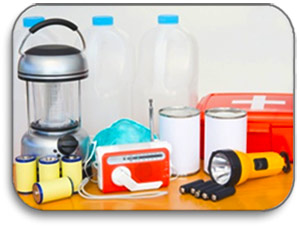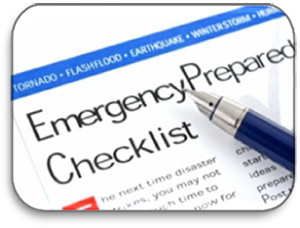Gather Supplies | Create a Plan
 Gather Emergency Supplies
Gather Emergency Supplies
Food and Water
- Three-day Water Supply: one gallon per person per day
- Water should be stored in sealed, unbreakable containers.
- Rotate the water supply every six months.
- Three-day supply of non-perishable food
- Powdered milk
- High energy foods – peanut butter, granola bars
- Sugar, salt, pepper
- Baby food and formula
Clothing & Bedding
- A complete change of clothing
- Outer wear/rain gear/hats/gloves
- Sturdy shoes/boots
- Thermal underwear
- Blankets or sleeping bags
Tools/Equipment
- Can opener (non-electric)
- A battery-powered radio
- Flashlights
- Supply of extra batteries
- Paper plates, cups, plastic utensils
- Paper towels
- Trash bags
- Matches in waterproof container
- Detergent
First Aid Supplies
- Bandages
- Anti-bacterial ointment
- Scissors, tweezers, needles, safety pins
- Thermometer
- OTC Medications — aspirin, allergy/cold medication
- Anti-bacterial towelettes, hand gel, soap
Personal Information and Supplies
- Medical information
- Identification documents
- Insurance, bank and credit card information
- Cash — small denominations
- An extra set of car keys
Special Items
- Prescription medications
- Extra eyeglasses
- Diapers, as appropriate
- Feminine hygiene products
Pets
- Food & Water
- Medical records & photo in a water tight bag
- Medications
- Leash, blanket, toys, ID tags
- Crate, cage or carrier for each pet if there is a need to evacuate
- Garbage bags for waste cleanup
 Create a Household Emergency Plan
Create a Household Emergency Plan
- Meet with household members to discuss emergencies such as fire, severe weather, chemical hazards
- Learn how to respond to different hazards
- Plan two escape routes
- Identify safe locations in your home for each hazard
- Discuss what to do for power outages
- Discuss what to do for personal injuries
- Post emergency telephone numbers near the telephones
- Teach children when to call 9-1-1
- Instruct household members to turn on the radio for emergency information
- Select contacts if household members are separated during an emergency (contacts should include one out-of-state person and one local person)
- Pick two emergency meeting places
• a place near your home in case of a fire.
• a place outside your neighborhood in case you cannot return home after a disaster
For more information go to ready.gov/kit

